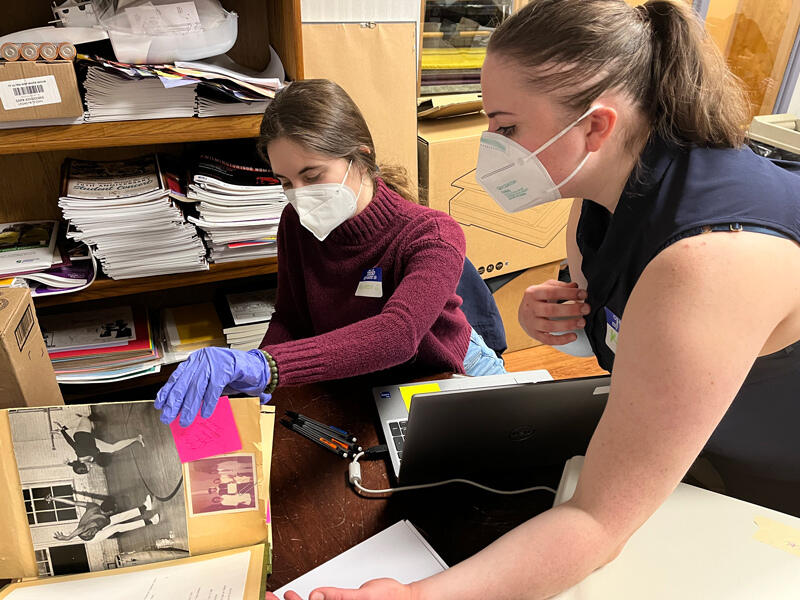
UD Museum Studies teams help local nonprofits manage their collections
A historic African American church, a community cultural arts center and a chapter of a national civil rights organization aren’t institutions that are thought of — even by their own members — as museums.
But in the case of these three Delaware organizations, they all have file cabinets and closets holding numerous photos, documents and other materials that give a picture of their own and their community’s rich history. Now, with the help of the University of Delaware’s Museum Studies Program, those important collections are being organized and converted into searchable physical and digital records.
During the Winter Session and spring semester of 2022, a team of nine museum studies graduate students worked on an annual service-learning project known as Collections Aid (or C-Aid). This year’s goal was to help these nonprofit organizations make their archives more accessible through cataloguing and digitizing their contents and, at the same time, helping students grow and put their knowledge and skills to use.
“It's very important that our students, and the community more broadly, recognizes that collections of important materials are not only housed in museums and archives,” said Kenneth Cohen, associate professor of history and director of museum studies at UD. “We're proud of our community partnerships that help local organizations research and care for these collections into the future.”
For student Melissa Benbow, C-Aid was “a meaningful experience that supported my professional development.” Working at Christina Cultural Arts Center (CCAC) in Wilmington, she and other students digitized thousands of records including photographs and event posters, documenting the center’s 75-year history of arts education.
“I learned how to scan photographs, magazines, newspapers and scrapbooks,” Benbow said, crediting the hands-on experience with helping her land the summer internship she wanted. “Of course, through engaging with these items I also got to learn a lot about the Christina Cultural Arts Center and all they have done for the Wilmington community.”

In addition to scanning collection contents, students entered metadata — defined as descriptive information that hews to a standardized lexicon — into a database to enable the newly digital records to be searched as needed.
“It was a privilege to organize and develop metadata for these [photo] albums, which document some of CCAC’s earliest years,” said student Christopher Loos, who added that the project was his first significant opportunity to work with metadata.
Because Loos plans a career in archival work, he said the experience was professionally valuable, “but more importantly, I’m happy to have made a small contribution to help CCAC document their history.”
He also joined other students for the C-Aid project at St. John African Methodist Church on New London Road in Newark. Founded in the mid-19th century, the church has a rich history of serving the community. Students rehoused St. John’s physical records and created a catalogue indexing them.
Benbow and Loos assembled a display case — using “our combined brains and brawn,” Loos said — and worked with the team to organize the church’s documents on such matters as finances and property management. The completed archive “now sits handsomely in the display case,” he said.
Although all the students developed connections with the organizations they were assisting, English doctoral student Brittney Henry said she felt that relationship especially strongly at the church.
“I had been mapping Black existence in Newark from 1820 to 1860 as a class project,” she said. “Older maps of Delaware have no Black names, only those of white landowners.
“Working with St. John was a different experience. It was amazing because I was helping a community space within Newark that told the history of the area.”
In the third part of C-Aid, students worked at the Wilmington Metropolitan Urban League, a chapter of the national civil rights and urban advocacy organization. In Wilmington, the team helped digitize thousands of policy proposals and program records into searchable files and built a digital alumni database the organization can use to connect with those it has served over the years.
“It was really great to learn how a digital archive was developed from scratch,” said student Maureen Iplenski about her work at the Urban League. “These institutional archives can serve a lot of purposes [and] can support the further growth of an organization. … I am excited to see how the continuation of this work will ultimately come to serve these organizations.”
About Museum Studies and Collections Aid
UD’s Museum Studies Program, founded in 1972, is one of the country’s oldest and best-known training programs for students interested in museums, archives and other organizations that share their expertise with the public.
Offering an undergraduate minor and a graduate certificate, the program focuses on service to the community and the field and on teaching a broad range of technical skills.
The voluntary Collections Aid service project, operating since 2010, has donated more than 4,000 hours of assistance to improve collections care at sites in and near Delaware.
This year’s C-Aid was supported by grants from UD’s Partnership for Arts and Culture and the art storage company UOVO. The funding supplied equipment and supplies, with each community partner keeping a laptop and a scanner to continue the work the students began.
The C-Aid teams worked under Cohen’s direction and included nine graduate students and program coordinator Tracy Jentzsch. Then-graduate assistant Kery Lawson, who holds a library degree and has archival experience, helped plan the C-Aid projects and instructed students on archival methods and theory.
Moving forward, Cohen said, “Collections Aid projects will aim to serve a diverse range of institutions with collections but which may not consider themselves ‘museums.’ As a result, Collections Aid will invite students to put their coursework into practice at a broader range of institutions that relate to the field.”
Graduate assistant and doctoral student Pamela Ahern contributed to this article.

